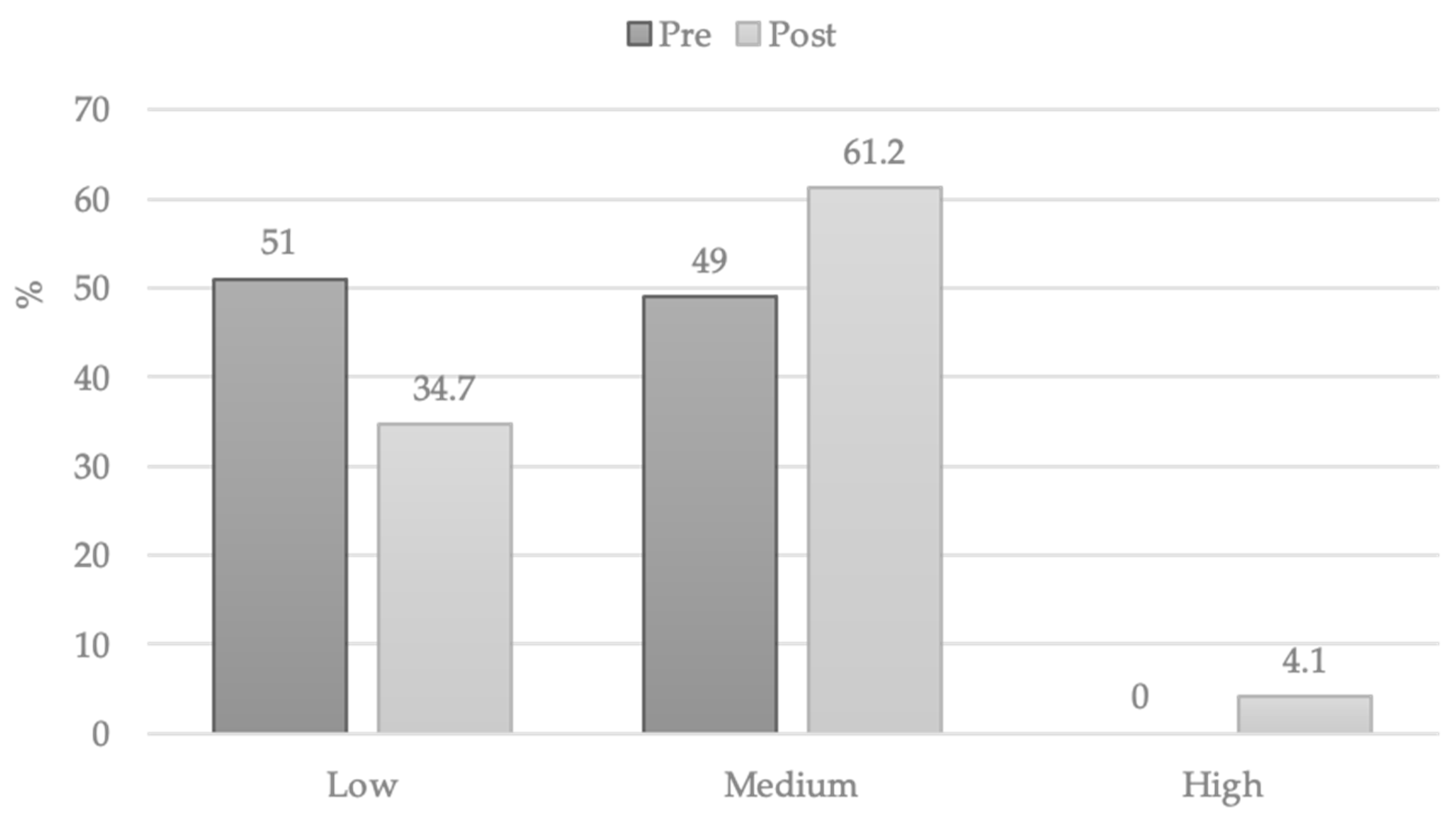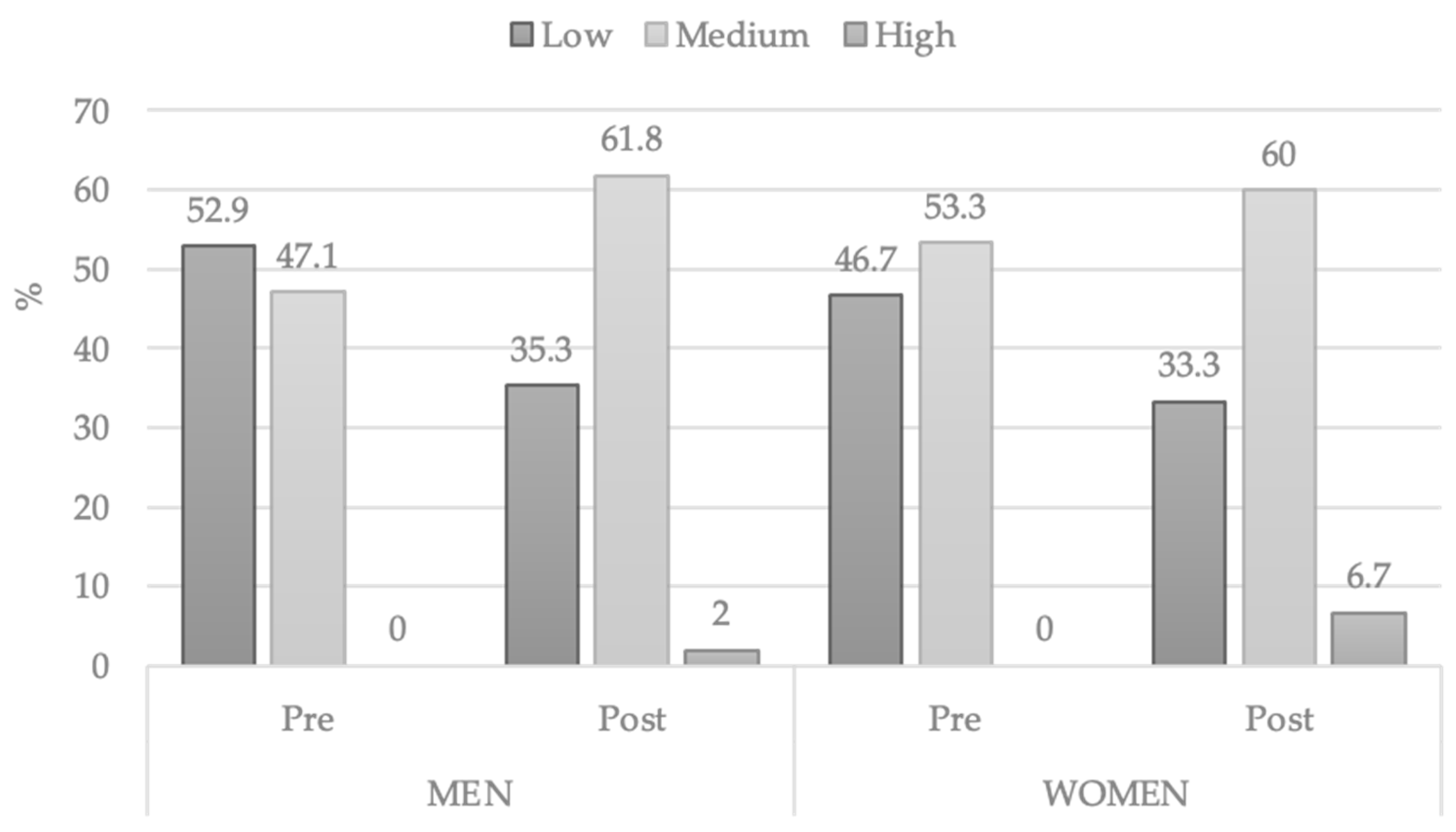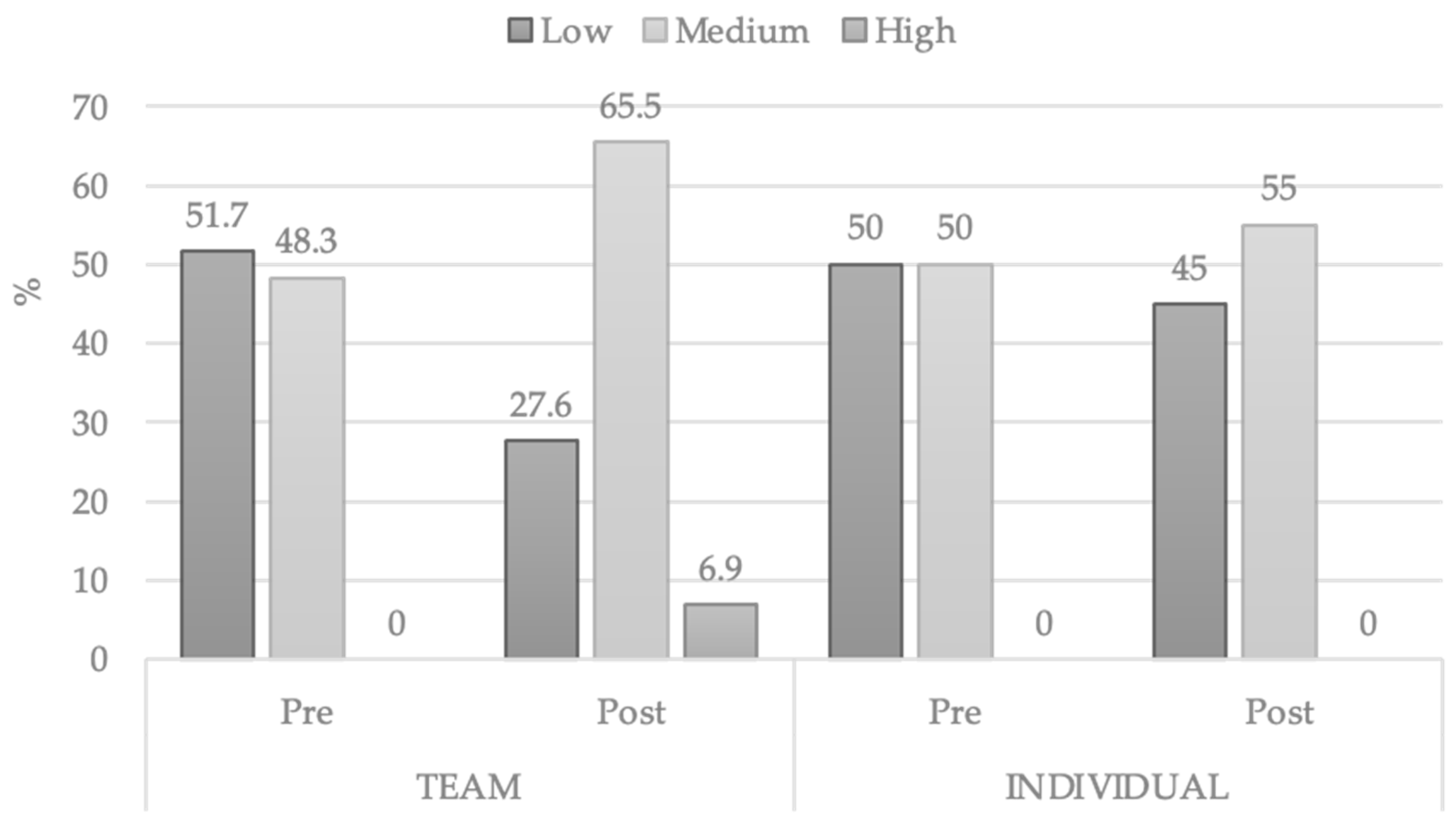Development of Creative Intelligence in Physical Education and Sports Science Students through Body Expression
Abstract
1. Introduction
2. Materials and Methods
2.1. Sample
- Attendance at classes less than 85%;
- Not completing the pre- or post-test.
2.2. Instrument
2.3. Procedure
2.4. Statistical Analysis
3. Results
- Women started with a higher score than men (24.20 mean and 7.804 SD), and although an improvement in their final average could be observed (26.47 mean and 7.990 SD), it was not significant (t = −2.041 p = 0.061 ES = 0.2).
- Men, on the other hand, in the pre-test achieved a lower mean (22.65 mean and 6.971 SD), but in the general mean of the post-test was noted a significant increase (t = −4.029 p < 0.001 ES = 0.6) of these values (26.09 mean and 7.412 SD).
4. Discussion
5. Conclusions
Author Contributions
Funding
Institutional Review Board Statement
Informed Consent Statement
Data Availability Statement
Conflicts of Interest
References
- Aparicio, M.L.; Mayorga-Vega, D.; López-Fernández, I. Expresión Corporal: Revisión bibliográfica sobre las características y orientaciones metodológicas en contextos educativos. Acciónmotriz 2019, 22, 23–34. [Google Scholar]
- Megías, M.E.P. Pensar el cuerpo: De la expresión corporal a la conciencia “expresivocorporal”, un camino creativo narrativo en la formación inicial del profesorado. Retos 2020, 37, 643–651. [Google Scholar]
- Redondo, M.A.; Gómez, C.C.; Bastida, A.; Mancha, D.; Gamonales, J.M. Are there differences in the emotions perceived by secondary education students as a result of sex and academic year in body expression sessions? Educ. Sport Health Phys. Act. 2019, 3, 15–28. [Google Scholar]
- López Miñarro, P.Á. Postura Corporal y Expression. 2009. Available online: https://digitum.um.es/digitum/handle/10201/5251 (accessed on 18 May 2021).
- Arriagada, K.R. El despertar de las emociones. Un trabajo corporal. Multiárea 2013, 6, 311–352. [Google Scholar]
- Arguedas Quesada, C. La expresión corporal y la transversalidad como un eje metodológico construido a partir de la ex-presión artística. Rev. Educ. 2004, 28, 123–131. [Google Scholar]
- Aranda, L.D.B.; Leita, E.A. La rítmica—música en movimiento—como estrategia de reeducación corporal y rehabilitación psicosocial en personas con problemas de salud mental. Artseduca 2020, 27, 186–198. [Google Scholar] [CrossRef]
- Sánchez, I.G.; Ordás, R.P.; Lluch, Á.C. Iniciación a la danza como agente educativo de la expresión corporal en la educación física actual: Aspectos metodológicos. Retos 2011, 20, 33–36. [Google Scholar]
- Leach, J.; Stevens, C.J. Relational creativity and improvisation in contemporary dance. Interdiscip. Sci. Rev. 2020, 45, 95–116. [Google Scholar] [CrossRef]
- Valverde-Esteve, T. Practical implications of the non-linear pedagogy in future physical Education Teachers Training during a body expression session: Towards the edge of chaos (Implicaciones prácticas de la pedagogía no-lineal en la formación del Profesorado de Educación F. Retos 2020, 40, 231–240. [Google Scholar] [CrossRef]
- Domínguez Iglesias, A.; Díaz Pereira, M.d.P.; Martínez Vidal, A. Estudio comparativo de los niveles de creatividad motriz en practicantes y no practicantes de expresión corporal. Retos 2014, 2041, 56–59. [Google Scholar]
- Baer, J.; Kaufman, J.C. Gender Differences in Creativity. J. Creat. Behav. 2008, 42, 75–105. [Google Scholar] [CrossRef]
- Mašanović, B. Gender and age differences in attitudes of Serbian pupils toward Physical Education lessons and their preferences regarding organisation of teaching methodology. Croat. J. Educ. 2019, 21. [Google Scholar] [CrossRef]
- Hughes, D.J.; Furnham, A.; Batey, M. The structure and personality predictors of self-rated creativity. Think. Ski. Creat. 2013, 9, 76–84. [Google Scholar] [CrossRef]
- Karwowski, M.; Gralewski, J.; Szumski, G. Teachers’ Effect on Students’ Creative Self-Beliefs Is Moderated by Students’ Gender. Learn. Individ. Differ. 2015, 44, 1–8. [Google Scholar] [CrossRef]
- Wellard, I. Men, sport, body performance and the maintenance of ‘exclusive masculinity’. Leis. Stud. 2002, 21, 235–247. [Google Scholar] [CrossRef]
- Sánchez, N.M.; Tejeda, M.E.V.; Alhuay-Quispe, J.; Chávez, F.A. La Creatividad en los Niños de Prescolar, un Reto de la Educación Contemporánea. REICE 2017, 15. [Google Scholar] [CrossRef]
- Berna, J.C. ¿De Qué Se Habla Cuando Hablamos De Creatividad? Fac. Humanid. Cienc. Soc. Univ. Nac. Jujuy 2008, 35, 11–21. [Google Scholar]
- Castro, V.; Susana, J. Estrategias para desarrollar la creatividad en los niños de etapa preescolar del Centro de Educación Inicial El Claveli-to, año lectivo 2016–2017. Bachelor’s Thesis, Universidad Politécnica Salesiana, Cuenca, Ecuador, 2018. [Google Scholar]
- D’Elia, F.; Mazzeo, F.; Raiola, G. The core curriculum in the university training of the teacher of physical education in Italy. J. Hum. Sport Exerc. 2018, 13, S413–S420. [Google Scholar] [CrossRef]
- Memmert, D. Sports and Creativity. Encycl. Creat. 2011, 2, 373–378. [Google Scholar]
- Williams, A.M.; Jackson, R.C. Anticipation and Decision Making in Sport; Routlegde: London, UK, 2019. [Google Scholar]
- Vaughan, J.; Mallett, C.J.; Davids, K.; Potrac, P.; López-Felip, M.A. Developing Creativity to Enhance Human Potential in Sport: A Wicked Transdisciplinary Challenge. Front. Psychol. 2019, 10, 1–16. [Google Scholar] [CrossRef]
- Aydin, E. The Effect of Spiritual Intelligence and Optimistic on Creativity in Team and Individual Sports Activities of Trabzon University Students. Asian J. Educ. Train. 2019, 5, 397–402. [Google Scholar] [CrossRef]
- Bowers, M.T.; Green, B.C.; Hemme, F.; Chalip, L. Assessing the Relationship Between Youth Sport Participation Settings and Creativity in Adulthood. Creat. Res. J. 2014, 26, 314–327. [Google Scholar] [CrossRef]
- Corbalán, J.; Martinez Zaragoza, F.; Donolo, D.; Alonso, C.; Tejerina, M.; Limiñana, R.M.E. CREA. Inteligencia Creativa, 3rd ed.; TEA Ediciones: Madrid, Spain, 2015. [Google Scholar]
- Łucznik, K. Between minds and bodies: Some insights about creativity from dance improvisation. Technoetic Arts 2015, 13, 301–308. [Google Scholar] [CrossRef]
- Pañego, M.M.; García, N.I. La creatividad en la expresión corporal. Un estudio de casos en educación secundaria. Apunts 2015, 4, 28–35. [Google Scholar] [CrossRef][Green Version]
- Torrents, C.; Castañer, M. Las consignas en la Expresión Corporal: Una puerta abierta para la creatividad y la creación coreográfica. Tándem 2009, 30, 111–120. [Google Scholar]
- Müller, P.; Rehfeld, K.; Schmicker, M.; Hökelmann, A.; Dordevic, M.; Lessmann, V.; Brigadski, T.; Kaufmann, J.; Müller, N.G. Evolution of Neuroplasticity in Response to Physical Activity in Old Age: The Case for Dancing. Front. Aging Neurosci. 2017, 9, 56. [Google Scholar] [CrossRef] [PubMed]
- Minsterova, A.S.; Klobusiakova, P.; Kropacova, S.; Novakova, L.; Brabenec, L.; Balazova, Z.; Grmela, R.; Skotakova, A.; Svobodova, L.; Rektorova, I. Multishell Diffusion MRI Reflects Improved Physical Fitness Induced by Dance Intervention. Neural Plast. 2020, 2020, 1–9. [Google Scholar] [CrossRef] [PubMed]
- Rektorova, I.; Klobusiakova, P.; Balazova, Z.; Kropacova, S.; Minsterova, A.S.; Grmela, R.; Skotáková, A.; Rektor, I. Brain structure changes in nondemented seniors after six-month dance-exercise intervention. Acta Neurol. Scand. 2020, 141, 90–97. [Google Scholar] [CrossRef] [PubMed]
- Ma, H.-H. The Effect Size of Variables Associated with Creativity: A Meta-Analysis. Creat. Res. J. 2009, 21, 30–42. [Google Scholar] [CrossRef]
- López Tejeda, A. El Desarrollo de la Creatividad a Través de la Expresión Corporal; Universidad Nacional de Educación a Distancia (UNED): Madrid, Spain, 2002. [Google Scholar]
- Pinheiro, I.R.; Cruz, R.M. Mapping Creativity: Creativity Measurements Network Analysis. Creat. Res. J. 2014, 26, 263–275. [Google Scholar] [CrossRef]
- Corbalan, J.; Martín-Brufau, R.; Limiñana, R.; García-Peñas, V. CREA.10 years in response to the question: Is it really possible to measure creativity? Pers. Individ. Differ. 2014, 60, S29. [Google Scholar] [CrossRef]
- Rebullido, T.R.; Lameiro, C.V. El Flashmob como propuesta de innovación educativa en expresión corporal y danza. Retos 2016, 29, 126–128. [Google Scholar]
- Cohen, J. Statistical Power Analysis/or the Behavioral Sciences; Academic Press: New York, NY, USA, 1988. [Google Scholar]
- Clapham, M.M.; King, W.R. Psychometric Characteristics of the CREA in an English Speaking Population. Ann. Psychol. 2010, 26, 206–211. [Google Scholar]
- Robinson, K.; Aronica, L. Escuelas Creativas; Grijalbo: Barcelona, Spain, 2015. [Google Scholar]
- Karpati, F.J.; Giacosa, C.; Foster, N.; Penhune, V.B.; Hyde, K.L. Dance and the brain: A review. Ann. N. Y. Acad. Sci. 2015, 1337, 140–146. [Google Scholar] [CrossRef] [PubMed]
- Amado, D.; Sánchez-Miguel, P.A.; Molero, P. Creativity associated with the application of a motivational intervention programme for the teaching of dance at school and its effect on the both genders. PLoS ONE 2017, 12, e0174393. [Google Scholar] [CrossRef]
- Reis, S.M. Toward a Theory of Creativity in Diverse Creative Women. Creat. Res. J. 2002, 14, 305–316. [Google Scholar] [CrossRef]
- Huang, L. Mind–Body Dissonance: A Catalyst to Creativity. Pers. Soc. Psychol. Bull. 2019, 46, 754–768. [Google Scholar] [CrossRef]
- Araya, Y.C. Una Revisión Crítica del Concepto de Creatividad. Actualidades Investigativas en Educación. 2005. Available online: https://www.redalyc.org/articulo.oa?id=44750106 (accessed on 18 May 2021).
- Stoltzfus, G.; Nibbelink, B.L.; Vredenburg, D.; Hyrum, E. Gender, Gender Role, and Creativity. Soc. Behav. Pers. Int. J. 2011, 39, 425–432. [Google Scholar] [CrossRef]
- Nori, R.; Signore, S.; Bonifacci, P. Creativity Style and Achievements: An Investigation on the Role of Emotional Competence, Individual Differences, and Psychometric Intelligence. Front. Psychol. 2018, 9, 1826. [Google Scholar] [CrossRef]
- Naderi, H.; Abdullah, R.; Aizan, H.T.; Sharir, J.; Kumar, V. Relationship between creativity and academic achievement: A study of gender differences. J. Am. Sci. 2010, 6, 181–190. [Google Scholar]
- Memmert, D.; Roth, K. The effects of non-specific and specific concepts on tactical creativity in team ball sports. J. Sports Sci. 2007, 25, 1423–1432. [Google Scholar] [CrossRef] [PubMed]



| Direct Score of CREA A + CREA B | Percentile | Creativity Level |
| 65 | 99 | High |
| 60–64 | 98 | |
| 56–59 | 97 | |
| 54–55 | 96 | |
| 53 | 95 | |
| 46–52 | 90 | |
| 42–45 | 85 | |
| 40–41 | 80 | |
| 38–39 | 75 | |
| 36–37 | 70 | Medium |
| 34–35 | 65 | |
| 33 | 60 | |
| 32 | 55 | |
| 30 | 50 | |
| 29 | 45 | |
| 28 | 40 | |
| 26–27 | 35 | |
| 24–25 | 30 | |
| 23 | 25 | Low |
| 20–22 | 20 | |
| 19 | 15 | |
| 17–18 | 10 | |
| 15–16 | 5 | |
| 13–14 | 4 | |
| 12 | 3 | |
| 11 | 2 | |
| 0–10 | 1 |
| 1st Session | First Contact with the Subject with Disinhibition Activities Through Specific Games with High Component of Fun (Impressions, Mime) |
| 2nd Session | Body knowledge and posture control: specific barre workout, stretching and body consciousness through relaxation techniques |
| 3th Session | Discover the space and the ways of displacement: formations and levels of movement |
| 4th Session | Learn to differentiate and follow different rhythms and intensities |
| 5th Session | Relationships development within the choreography: equals, mirror, different, alike, and complementary |
| 6th Session | Basic techniques used in traditional dances; coordination and creativity |
| 7th Session | Representation of group choreography and evaluation |
| Test | n | Mean | SD | |
|---|---|---|---|---|
| CREA Pre | Low Level | 25 | 17.40 | 4.406 |
| Medium Level | 24 | 29.08 | 3.866 | |
| High Level | 0 | - | - | |
| CREA Post | Low Level | 17 | 17.94 | 4.293 |
| Medium Level | 30 | 30.04 | 4.081 | |
| High Level | 2 | 39 | 1.414 |
| Test | Level | Gender | |||||
|---|---|---|---|---|---|---|---|
| Men | Women | ||||||
| n | Mean | SD | n | Mean | SD | ||
| CREA Pre | Low | 18 | 17.39 | 4.368 | 7 | 17.43 | 4.860 |
| Medium | 16 | 28.56 | 3.847 | 8 | 30.13 | 3.944 | |
| High | 0 | - | - | 0 | - | - | |
| CREA Post | Low | 12 | 18 | 3.742 | 5 | 17.80 | 5.933 |
| Medium | 21 | 30.05 | 4.189 | 9 | 30 | 4.065 | |
| High | 1 | 40 | - | 1 | 38 | - | |
| Sport | Test | n | Mean | SD | p | ES |
|---|---|---|---|---|---|---|
| Team | CREA Pre | 29 | 22.93 | 6.41 | 0.001 | 0.6 |
| CREA Post | 29 | 27.31 | 7.31 | |||
| Individual | CREA Pre | 20 | 23.40 | 8.36 | 0.231 | 0.1 |
| CREA Post | 20 | 24.60 | 7.69 |
| Test | Sport | ||||||
|---|---|---|---|---|---|---|---|
| Team | Individual | ||||||
| n | MEAN | SD | n | MEAN | SD | ||
| CREA Pre | Low Level | 15 | 18.13 | 4.274 | 10 | 16.30 | 4.596 |
| Medium Level | 14 | 28.07 | 3.731 | 10 | 30.50 | 3.779 | |
| High Level | 0 | - | - | 0 | - | - | |
| CREA Post | Low Level | 8 | 18.13 | 4.357 | 9 | 17.78 | 4.494 |
| Medium Level | 19 | 29.95 | 3.965 | 11 | 30.18 | 4.468 | |
| High Level | 2 | 39 | 1.414 | 0 | - | - | |
Publisher’s Note: MDPI stays neutral with regard to jurisdictional claims in published maps and institutional affiliations. |
© 2021 by the authors. Licensee MDPI, Basel, Switzerland. This article is an open access article distributed under the terms and conditions of the Creative Commons Attribution (CC BY) license (https://creativecommons.org/licenses/by/4.0/).
Share and Cite
Vidaci, A.; Vega-Ramírez, L.; Cortell-Tormo, J.M. Development of Creative Intelligence in Physical Education and Sports Science Students through Body Expression. Int. J. Environ. Res. Public Health 2021, 18, 5406. https://doi.org/10.3390/ijerph18105406
Vidaci A, Vega-Ramírez L, Cortell-Tormo JM. Development of Creative Intelligence in Physical Education and Sports Science Students through Body Expression. International Journal of Environmental Research and Public Health. 2021; 18(10):5406. https://doi.org/10.3390/ijerph18105406
Chicago/Turabian StyleVidaci, Andreea, Lilyan Vega-Ramírez, and Juan Manuel Cortell-Tormo. 2021. "Development of Creative Intelligence in Physical Education and Sports Science Students through Body Expression" International Journal of Environmental Research and Public Health 18, no. 10: 5406. https://doi.org/10.3390/ijerph18105406
APA StyleVidaci, A., Vega-Ramírez, L., & Cortell-Tormo, J. M. (2021). Development of Creative Intelligence in Physical Education and Sports Science Students through Body Expression. International Journal of Environmental Research and Public Health, 18(10), 5406. https://doi.org/10.3390/ijerph18105406







